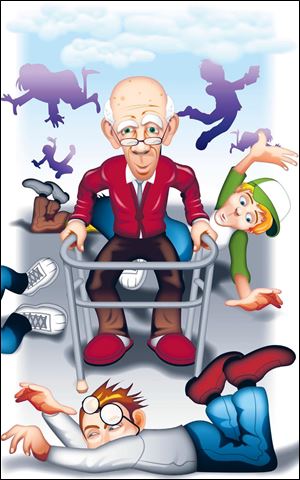
Falls aren't just an issue for the elderly
9/23/2012
The Ohio Injury Prevention Partnership lists "falls among older adults" first in its list of injury priority areas, but taking a bad tumble also is a critical problem for Ohioans in other age groups.
A state department of health report says falls were the leading cause of injury-related visits to emergency rooms and hospitalizations between 2002 and 2005.
"For children younger than 14 years and adults aged 45 years and older, falls lead to more hospitalizations than any other injury," the report states.
The document also said that hospitalizations from falls cost $1.2 billion in those years, which was more than hospitalizations required for injuries from motor vehicle traffic, self-harm, assault, and unintentional poisoning combined. And it is impossible to put a price on the grief that families face when a loved one has a fatal fall, or the stress they have from overseeing hospital and rehabilitative care for a relative who falls.
Precautions to reduce the risks involves more than making sure throw rugs are securely fastened to the floor and that floors and stairs are clear of clutter.
One out of three older adults falls in this country every year. That's behind a Senate resolution passed earlier this month marking Sept. 22 as National Falls Prevention Awareness Day. It is a serious problem among senior citizens, but people of all ages should be educated about the problem, which can happen anywhere at any time.
Pam Toto proves that a person doesn't have to be elderly and frail to fall. Two years ago, the physically fit professor of occupational therapy at the University of Pittsburgh was 43 years old when she fell down stairs and fractured her wrist, requiring surgery.
"What we know in general is that falls are caused by a lot of different reasons," she said. "The research strongly tells us that there are multiple factors that contribute to falls, and environment is one of the risk factors."
Ms. Toto was carefully descending stairs when her high-heel shoe got caught on a step, causing her to pitch forward and land on her hand.
"It was dark, I had heels on, and was in an unfamiliar environment," she said.
Robyn Pitock, occupational therapist at Total Rehab at Flower Hospital in Sylvania, said that while it's important to use nonskid rugs, a raised toilet seat, and grab bars by the toilet and in the tub or shower in bathrooms, good lighting and switches at the top and bottom of stairs that have hand rails on both sides are vital. Declutter and remove cords from walkways, use night lights, and keep a lamp by the bed for night use.
"The height of the chair or bed shouldn't be below the height of the back of your knee," said Ms. Pitock.
Tori Goldhammer, owner of Living at Home Consultations in Washington, said occupational therapists know the importance of furniture style and arrangement to reduce the risks. When a builder showed her a drawing for a bathroom modification, she had to step in with more suggestions.
"He added a grab bar behind the toilet, when in fact the man needs grab bars on both sides," Ms. Goldhammer said.
Ms. Toto said other factors that play a role in falls may have to do with environment, walking speed, medications, or people's cognitive abilities.
Uneven sidewalks, wet leaves, and chairs not pushed back up to a table can pose risks. So can pets. Ms. Toto told a story about a couple's dog. While cutting grass, the man tripped on the dog's leash as it ran by him. He fell and broke his arm. As his wife cared for him, she tripped over the dog and fractured her pelvis.
Karen Smith, a practice associate specializing in fall prevention and home modification for the American Occupational Therapy Association, said from her Washington office that footwear can be an issue, and not just women's high heels, but slippers and open-toe shoes. Good footwear and getting annual eye exams help to prevent falls, she said.
Texting and walking can be as dangerous as texting and driving.
"[Texting] is a risky thing, and if you combine that with walking in high heels and texting and walking across the street, if you get to the other side safely, you are amazing," Ms. Smith said.
Natalie Leland, an assistant professor of occupational therapy at the University of Southern California, said that exercise can lower fall risks.
"It's important to continue to be active and make sure we are living healthy lifestyles and engaging in activities that are important to us," she said.
Contact Rose Russell at: rrussell@theblade.com or 419-724-6178.